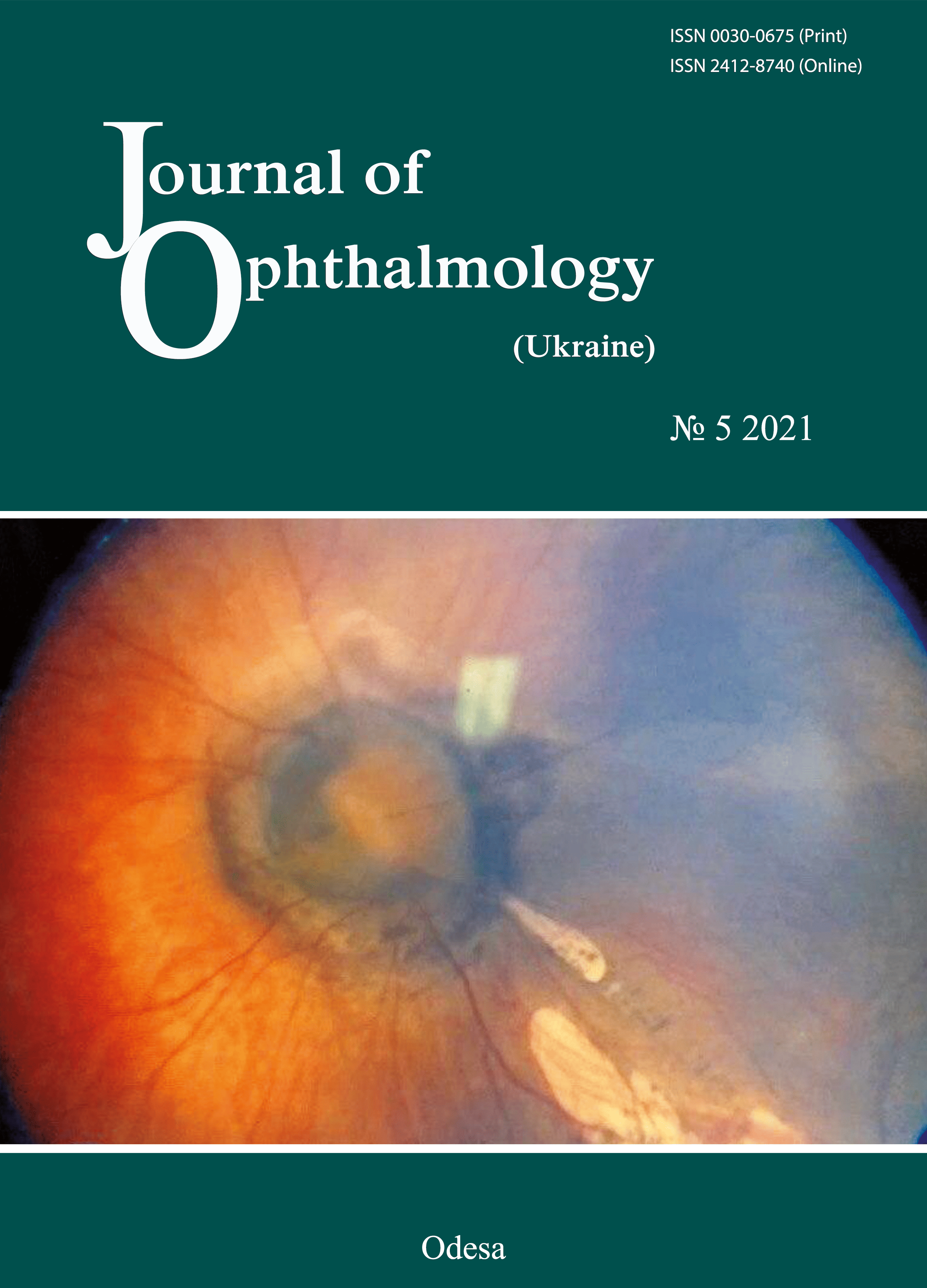Morphological, functional and structural changes in red blood cells of type 2 diabetes patients with proliferative diabetic retinopathy and different diabetes duration
DOI:
https://doi.org/10.31288/oftalmolzh202152127Keywords:
osmotic, mechanical hemolysis, hyperglycemia, glycated hemoglobin, impaired microcirculationAbstract
Background: Hyperglycemia alters erythrocyte membrane properties, and the reduced Na+,K+-ATPase activity results in ionic imbalance and changes in size and osmotic resistance of red blood cells (RBCs), accelerates cell aging, and contributes to impaired microvascular circulation.
Purpose: To assess morphological, functional and structural changes in RBCs of type 2 diabetes patients with proliferative diabetic retinopathy (PDR) and different diabetes duration.
Material and Methods: One hundred and six type 2 diabetes patients with PDR were included in the study. The control group (n=37) included volunteers without diabetes of age, gender and body-mass-index comparable to patients. Morphological and functional parameters of RBCs were determined using a MicroСС-20Рlus auto hematology analyzer (China). Percentages of hemolysis of erythrocytes in 0.1%; 0.2%, 0.3%, 0.35%, 0.4%, 0.45%, 0.5%, 1.0%, and 0.9% NaCl-buffer solutions were determined. We also determined mechanical chemolysis levels after centrifugation for 2 min and 4 min.
Results: At 0.9% NaCl, osmotic hemolysis was 3.0-3.3-fold higher (р < 0.05) in PDR patients than in healthy individuals, but there was no significant difference in osmotic hemolysis between PDR patients with different durations of T2D. At 0.5% NaCl and 0.45% NaCl, PDR patients had percentages of hemolysis that were 3.5-4.0-fold higher (р < 0.05) and 2.0-2.5-fold higher (р < 0.05), respectively, than in controls. At 1.0% NaCl, there was a two-fold difference (р < 0.05) in RBC membrane resistance between patients and controls. In addition, patients with diabetes duration of 18 to 20 years were found to have erythrocytes with the highest resistance to damage. The percentages of hemolyzed RBCs after centrifuging for 2 min were 2.6 to 3-fold higher, and after centrifuging for 4 min, 3.0 to 3.75-fold higher, in patients relative to those in control subjects
Conclusion: Compared to controls, patients with PDR exhibited signs of a relatively short residence time of RBCs in the circulation due to early cell membrane damage. The reduced structural resistance and loss of capability for effective perfusion in RBCs in the presence of PDR leads to a further impairment of microcirculation.
References
1.Wang Y, Yang P, Yan Z, et al. The relationship between erythrocytes and Diabetes Mellitus. J Diabetes Res. 2021 Feb 5;2021:6656062.https://doi.org/10.1155/2021/6656062
2.Cheung N, Mitchell P, Wong TY. Diabetic retinopathy. Lancet. 2010 Jul 10;376(9735):124-36.https://doi.org/10.1016/S0140-6736(09)62124-3
3.Waheed N. Proliferative Diabetic Retionopathy. In: Goldman DR, Waheed NK, Duker JS. Atlas of retinal OCT. Edinburgh: Elsevier; 2018.https://doi.org/10.1016/B978-0-323-46121-4.00039-X
4.Ford J. Red blood cell morphology. Int J Lab Hematol. 2013 Jun;35(3):351-7.https://doi.org/10.1111/ijlh.12082
5.Chang HY, Li X, Karniadakis GE. Modeling of Biomechanics and Biorheology of Red Blood Cells in Type 2 Diabetes Mellitus. Biophys J. 2017 Jul 25;113(2):481-490.https://doi.org/10.1016/j.bpj.2017.06.015
6.Palomino-Schätzlein M, Lamas-Domingo R, Ciudin A, et al. A Translational In Vivo and In Vitro Metabolomic Study Reveals Altered Metabolic Pathways in Red Blood Cells of Type 2 Diabetes. J Clin Med. 2020 May 27;9(6):1619.https://doi.org/10.3390/jcm9061619
7.Rownak N, Akhter S, Khatun M, et al. Study of Osmotic Fragility Status of Red Blood Cell in Type II Diabetes Mellitus Patients. Eur J Environ Public Health. 2017;1(2):6.https://doi.org/10.20897/ejeph/77094
8.Kung CM, Tseng ZL, Wang HL. Erythrocyte fragility increases with level of glycosylated hemoglobin in type 2 diabetic patients. Clin Hemorheol Microcirc. 2009;43(4):345-51.https://doi.org/10.3233/CH-2009-1245
9.Blaslov K, Kruljac I, Mirošević G, et al. The prognostic value of red blood cell characteristics on diabetic retinopathy development and progression in type 2 diabetes mellitus. Clin Hemorheol Microcirc. 2019;71(4):475-81.https://doi.org/10.3233/CH-180422
10.Kor C-T, Hsieh Y-P, Chang C-C, Chiu P-F. The prognostic value of interaction between mean corpuscular volume and red cell distribution width in mortality in chronic kidney disease. Sci Rep. 2018 Aug 8;8(1):11870.https://doi.org/10.1038/s41598-018-19881-2
11.Bissinger R, Bhuyan AAM, Qadri SM, Lang F. Oxidative stress, eryptosis and anemia: a pivotal mechanistic nexus in systemic diseases. FEBS J. 2019 Mar;286(5):826-854.https://doi.org/10.1111/febs.14606
12.Qadri SM, Bissinger R, Solh Z, Oldenborg P-A. Eryptosis in health and disease: A paradigm shift towards understanding the (patho)physiological implications of programmed cell death of erythrocytes. Blood Rev. 2017 Nov;31(6):349-61.https://doi.org/10.1016/j.blre.2017.06.001
13.Ferents ІV, Brodyak IV, Lyuta MIa, et al. [Effects of decarboxylated L-arginine on morphofunctional characteristics of the erythron in experimental diabetes mellitus in rats]. Fiziol Zh. 2014;60(4):70-9. Ukrainian.https://doi.org/10.15407/fz60.04.070
14.Lee S, Lee MY, Nam JS, et al. Hemorheological approach for early detection of chronic kidney disease and diabetic nephropathy in type 2 diabetes. Diabetes Technol Ther. 2015 Nov;17(11):808-15.https://doi.org/10.1089/dia.2014.0295
15.Padmini H, Bhagwat K. Monitoring Glycosylated Haemoglobin and Osmotic Fragility with Respect to Blood Glucose Level in Type II Diabetes Mellitus. IJHSR. 2015 Apr;5(4):171-74. Available at: https://www.ijhsr.org/IJHSR_Vol.5_Issue.4_April2015/29.pdf
Downloads
Published
How to Cite
Issue
Section
License
Copyright (c) 2025 В. М. Ганюк , О. В. Петренко , Л. В. Натрус , О. І. Прусак

This work is licensed under a Creative Commons Attribution 4.0 International License.
This work is licensed under a Creative Commons Attribution 4.0 International (CC BY 4.0) that allows users to read, download, copy, distribute, print, search, or link to the full texts of the articles, or use them for any other lawful purpose, without asking prior permission from the publisher or the author as long as they cite the source.
COPYRIGHT NOTICE
Authors who publish in this journal agree to the following terms:
- Authors hold copyright immediately after publication of their works and retain publishing rights without any restrictions.
- The copyright commencement date complies the publication date of the issue, where the article is included in.
DEPOSIT POLICY
- Authors are permitted and encouraged to post their work online (e.g., in institutional repositories or on their website) during the editorial process, as it can lead to productive exchanges, as well as earlier and greater citation of published work.
- Authors are able to enter into separate, additional contractual arrangements for the non-exclusive distribution of the journal's published version of the work with an acknowledgement of its initial publication in this journal.
- Post-print (post-refereeing manuscript version) and publisher's PDF-version self-archiving is allowed.
- Archiving the pre-print (pre-refereeing manuscript version) not allowed.












